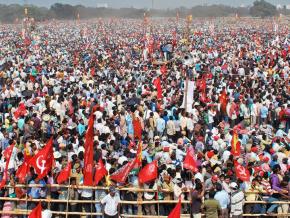A march against Modi shuts down Kolkata
A massive rally of up to 2 million people took place in Kolkata, capital of the Indian state of West Bengal, on February 3, just three months before Indians go to the polls to elect a new central government. The rally was a show of strength by the Left Front — the party that held power in West Bengal for more than three decades until it was ousted in 2011 — and a challenge to the hard-right government of Indian Prime Minister Narendra Modi.
In this eyewitness account published at the Australian newspaper Red Flag, describes the mass mobilization that brought Kolkata to a standstill.
IN THE lead-up to the Left Front’s electoral launch on February 3, I was warned by comrades and taxi drivers alike that traffic would be bedlam. Working-class people from all over West Bengal, India’s fourth most populous state, were descending on Kolkata’s Brigade Parade Ground in a show of force against the right-wing state and central governments. The rest of Kolkata knew in advance that they had no choice but to bend and twist for this mammoth assembly.
Everyone seemed aware something big was coming. Red flags were planted in the middle of roads, hung from verandas, rooftops and high-rise windows. Trucks emblazoned in red drove through the suburbs, blaring working-class jingles.

A tense political contest was glued and stapled across the city, the competing forces plastering Kolkata. Old posters from the incumbent Trinamool Congress’ electoral rally were still up — mostly thousands of glossy roadside portraits of chief minister Mamata Banerjee. The left’s favorite advertising method seemed to be graffiti — in Bangla, Hindi, Urdu or English, straight on the side of corporate buildings.
Come rally day, the demonstration was due to start at 1 p.m. I left home at 10 a.m., but no taxi would go further than the adjoining suburb, even at that early hour. With the roads poorly marked and the Internet failing, I was worried about getting lost.
Then, left-wing chants sounded out as hundreds of unionists in red bucket-hats turned a corner, red flags billowing. I followed the procession of Murshidabad unionists to the grounds. As we approached, megaphones hoisted on lampposts drew in thousands upon thousands of people from almost a kilometer away. Gradually, the numbers of people swelled, and dozens of trucks, buses and other vehicles draped in the red flag parked along the side of the route.
Inside the parade ground, more than 100,000 people had gathered hours before the official start. It was already the biggest rally I’d ever seen. And it kept building. Perhaps 2 million turned out. It was hot, dusty and cramped. To navigate the throng, strangers held each other’s shoulders for balance, like a conga line.
The Communist Party (Marxist) is dominant in the Left Front coalition, leading 10 other parties. The Left Front held power in Bengal for 34 years. It carried out neoliberal attacks, made way for private development in agriculture and failed to challenge communalism. It was ousted in disgrace in 2011, losing in a landslide to the Trinamool Congress. It’s baffling to consider that this monumental demonstration represented a weakened left. The mood was still combative.
“Today, we tried to gather all similar-minded people to fight hand in hand for the democracy of India and for socialism all over the world, for the equal division of wealth,” Gautum Kumar, from Ganamukti Parisad, a Tripura arm of the CPI-(M) organizing agricultural workers, told me.
Brijagopal Masanta, a teacher from Paschim Mednipur, travelled three hours with 50 of his colleagues for the event. Patient with my imperfect Bangla, he said: “The poor, those who work to eat, those who have fallen behind, have to fight the central government that is attacking our democracy.”
First published at Red Flag.


